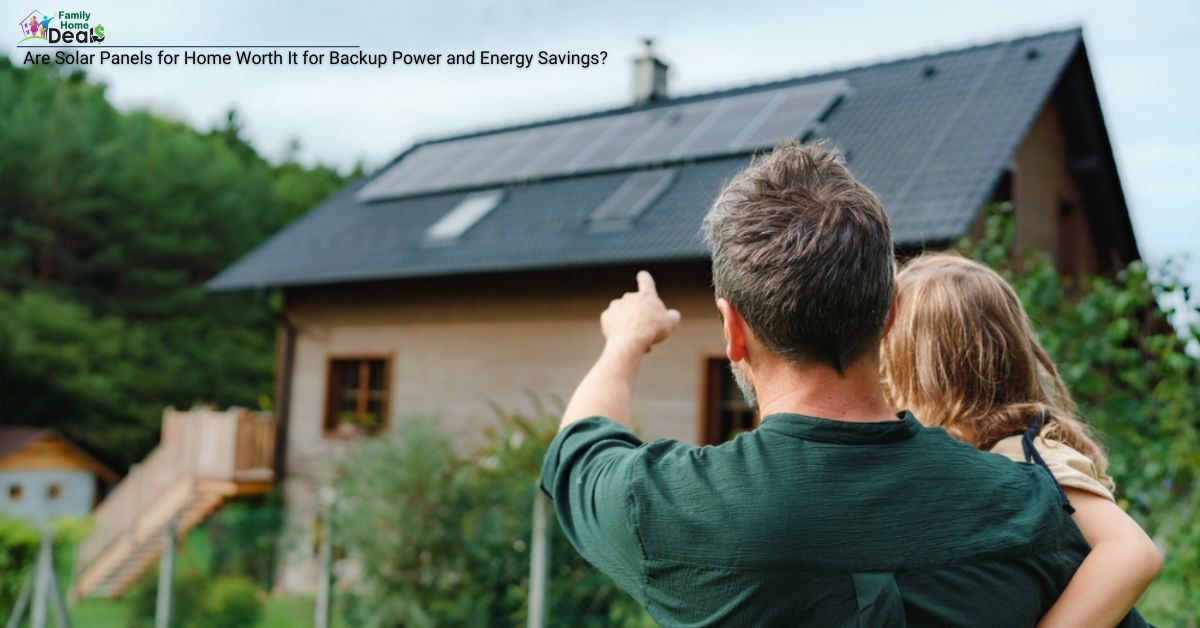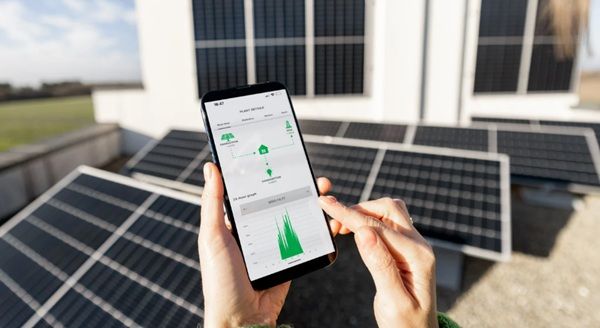
Picture this: it’s the middle of summer, the power grid fails during a heatwave, and your neighbors scramble for candles and ice coolers. Meanwhile, your fridge hums, your Wi-Fi stays connected, and your lights shine bright—all powered by solar panels for home with backup storage. Sounds like a dream, right?
But here’s the catch: installing solar isn’t just about resilience. Many homeowners jump in, hoping to slash their monthly electricity bills, too. That’s where the decision gets tricky. Are solar panels for home worth the upfront investment as both a backup solution and a money saver—or is the reality more complicated?
This article takes you through the facts, myths, and real-life numbers behind solar power. We’ll unpack the costs, savings, and trade-offs—plus give you a step-by-step guide to see if it’s right for your lifestyle. By the end, you’ll know whether solar panels are a wise upgrade or an expensive backup plan.
Why Homeowners Are Turning to Solar Panels
The Double Promise: Savings + Security
When most people think about solar, they picture lowering their electric bills—and that’s true. But increasingly, backup power is a big part of the appeal.
-
Savings: Solar panels can offset 50–100% of your bill, depending on system size and household usage.
-
Backup: With a battery, your essential loads (fridge, lights, internet) stay powered during outages.
The tension is that maximizing one often compromises the other. A solar-only system gives the fastest payback, but zero resilience. A solar + battery system protects you from outages, but the extra cost stretches your payback timeline.
Quick Fact: A 2025 Stanford study found that 60% of U.S. households could save 15% on bills and handle blackouts by combining solar panels for home with storage.
The Pressure Cooker: Bills and Outages
-
In the U.S., residential electricity prices rose by nearly 15% between 2021–2024, with further increases expected.
-
In the U.K., the 2022 energy crisis pushed many households to pay double or triple their usual rates.
-
Across Europe, gas shortages and grid instability made renewables a hot topic at every dinner table.
These realities make solar panels for home more than just an eco-choice—they’re increasingly a financial and security hedge.
The Real Cost of Solar Panels for Home
Here’s what it typically looks like if you go solar:
Upfront Costs: The Big Picture
-
System installation (panels + inverters): $2.50–$3.30 per watt in the U.S.
-
12 kW system after incentives: ~$20,754 (EnergySage, 2025).
-
Without incentives: often $24,000–$36,000.
-
UK homeowners: Average system cost is £6,000–£8,000 for a 4 kW setup.
Battery Storage: The Backup Price Tag
-
Single home battery: $10,000–$19,000 installed.
-
Whole-home backup: $3,000–$15,000 more, depending on load size.
-
UK range: £2,500–£7,000 depending on battery size.
Add it up: a full solar + battery setup can easily reach $30,000+ (or £10,000+ in the UK).
Comparison Snapshot
| Metric | Solar Only (Grid-Tied) | Solar + Battery Backup |
|---|---|---|
| Upfront Cost | Lower | Much higher |
| Payback Period | 5–10 years | 10–15 years (battery adds cost) |
| Outage Resilience | None | Yes (partial or full-home) |
| Efficiency | High | 10–20% lost in storage cycling |
| Maintenance | Low | Moderate (battery replacement needed) |
Real-Life Anecdote: Mark’s Texas Solar Setup
Mark, a homeowner in Houston, installed a 10kW solar system with a Tesla Powerwall. His bills dropped by about 70%, saving him nearly $150/month. During a 3-day storm outage, his system kept his fridge, lights, and internet running.
His verdict? “If I had gone solar-only without the battery, I’d have saved money—but I’d still have been in the dark.”
Contrast that with Sophie, a homeowner in Manchester, UK. She installed solar without a battery, using net metering. Her annual bill savings average £600, but when storms cut the power for 12 hours, her panels shut off too.
👉 The key takeaway: backup power requires batteries—otherwise, solar panels won’t keep the lights on during outages.
Solar Panels for Home: Economic Sense or Expensive Luxury?
So, is it worth it? Let’s weigh both sides.

The Upside
-
Bill reductions: Average savings $1,000–$2,000/year in the U.S.; £400–£800 in the UK.
-
Incentives: U.S. 30% federal tax credit, UK zero-VAT on domestic solar.
-
Home value boost: ~$15,000 in U.S. resale; 5–8% increase in the UK.
-
Resilience: Peace of mind during outages.
The Challenges
-
High upfront cost, especially with storage.
-
Payback delays: Batteries extend breakeven.
-
Degradation: Panels lose ~0.5% efficiency per year; batteries last ~10–15 years.
-
Regional factors: Cloudy climates and low grid prices reduce ROI.
Energy Burden Study: Real-Life Numbers
A Berkeley Lab study (2024) analyzed 500,000 households:
-
Rooftop solar reduced energy burden for 76% of adopters.
-
Median bill savings: $1,987/year.
-
Net savings (after financing): $691/year.
👉 Translation: Cash buyers see strong returns. Loan-based buyers see slower—but still positive—gains.
Step-by-Step Guide: Should YOU Go Solar?
Here’s how to decide if solar panels for home are right for you. Think of this as your homeowner’s checklist before signing any contracts.
1. Review Your Energy Bills
Don’t just glance at your latest bill—pull a full 12 months of data. This helps smooth out seasonal changes (like higher winter heating or summer A/C use).
-
Look at your average monthly kWh usage.
-
Note peak demand periods—if your utility charges more at certain hours, solar savings can be higher if you shift usage.
-
Example: A household using 900 kWh/month may need a 7–8 kW system, while a heavy-use household (1,500 kWh/month) might need 12 kW or more.
2. Audit Your Roof
Not every roof is solar-ready.
-
Orientation: South-facing roofs in the Northern Hemisphere capture the most sun. East or west can still work but with slightly reduced efficiency.
-
Shading: Tall trees, chimneys, or neighboring buildings reduce performance.
-
Condition: If your roof needs replacing in the next 5 years, it’s wise to do that first. Panels typically last 25+ years—you don’t want to uninstall them halfway.
-
Angle: Roof pitch matters—too flat or too steep reduces generation, though mounts can compensate.
3. Get Multiple Quotes
Treat this like buying a car—never settle for one installer’s pitch.
-
Compare at least 3 quotes.
-
Ask for system size, expected production, warranties, and monitoring tools.
-
Request a clear breakdown of equipment vs. labor vs. permits so you can see where your money is going.
-
Red flag: If an installer pushes a deal that “expires tomorrow,” step back—good companies give you time to decide.
4. Check Incentives
Government incentives can make or break ROI.
-
United States: Federal tax credit of 30% for solar and batteries (through 2032). Some states add rebates or net metering programs.
-
United Kingdom: 0% VAT on solar panels since 2022; Smart Export Guarantee (SEG) pays you for surplus energy exported to the grid.
-
Europe: Many EU nations offer grants or low-interest financing.
👉 Always confirm local eligibility—rules change often and can save you thousands.
5. Decide on Backup Level
Batteries don’t have to cover your whole home. Think carefully about what you really need in a blackout.
-
Partial Backup: Keeps essentials running (fridge, Wi-Fi, some lights). Cheaper—usually 1–2 batteries.
-
Whole-Home Backup: Runs everything, including A/C or electric heating. Expensive—requires multiple batteries.
Example: During California’s wildfire shutoffs, many families opted for partial backup—enough to stay comfortable, not run everything.
6. Run Payback Scenarios
Solar math isn’t always simple, but here’s the gist:
-
Compare your grid electricity rate (¢/kWh) vs. your solar system’s levelized cost of energy (LCOE).
-
Factor in battery efficiency losses (10–20%).
-
Ask installers to provide payback timelines—5–10 years is common for solar-only; 10–15 with storage.
Tip: If your utility bill is already low ($50–$70/month), ROI may be weak. If it’s $200+ monthly, solar almost always makes sense.
7. Plan for Growth
Think beyond today.
-
EV Owners: Charging at home with solar is one of the biggest money savers—potentially $1,000+ per year in fuel cost offsets.
-
Heat Pumps: If you plan to replace gas or oil heating with electric, size your system larger.
-
Future-Proofing: It’s often cheaper to oversize slightly now than to add panels later.
Pro Tip: Always ask installers to provide both a “solar-only” and a “solar + battery” proposal. Comparing them head-to-head makes the financial trade-off clear and avoids surprises down the road.
Jackery: Powering Adventures, Anywhere
When it comes to portable power solutions, Jackery leads the charge. Known for innovation and a commitment to sustainability, Jackery delivers more than just power — it delivers peace of mind. From portable power stations and solar panels to smart accessories, every product is designed to bring clean, reliable energy wherever life takes you. Explore the full lineup at jackery.com and discover why outdoor enthusiasts, travelers, and everyday households trust Jackery to keep life moving.
Common Pitfalls to Avoid
-
Overestimating solar output – Weather, shading, and dust reduce generation.
-
Ignoring soft costs – Permits, labor, and upgrades add thousands.
-
Oversizing batteries – Don’t pay for more backup than you’ll use.
-
Financing traps – High-interest loans or leases eat up your savings.
-
Forgetting replacements – Inverters last 10–15 years, batteries degrade.
Seasonal & Lifestyle Considerations
-
Winter vs. Summer: Expect lower generation in December/January, higher in June/July.
-
Hot vs. Cold Climates: Extreme heat reduces panel efficiency; cold reduces battery life.
-
Remote Workers: Backup power can mean the difference between a normal workday and lost income.
-
Families vs. Retirees: Heavy appliance use vs. light daytime loads affect ROI differently.
-
EV Owners: Solar panels for home pair beautifully with electric vehicles—charging during the day maximizes use of your own energy.
Frequently Asked Questions
Q1: Will solar panels work during a power outage?
No—unless you have a battery system. Grid-tied systems shut down for safety during outages.
Q2: What if I move houses?
Solar can raise resale value by ~$15,000 in the U.S. and ~5–8% in the UK. It’s an asset, not a liability.
Q3: What about renters?
Renters can’t typically install solar, but community solar or landlord agreements may be options.
Q4: How long do solar panels last?
Most panels are warrantied for 25 years with ~80% efficiency at year 25.
Q5: Is solar still worth it in cloudy places?
Yes—but ROI is slower. Germany, one of the cloudiest countries in Europe, is a global solar leader.
Conclusion
Installing solar panels for home is not just about saving money—it’s about taking control. If your area has high electricity rates, strong incentives, and frequent outages, solar plus storage can pay off in both dollars and peace of mind.
But remember: batteries add significant costs. If your priority is only savings, a grid-tied solar-only system may be smarter. If blackout protection is crucial, investing in backup makes sense—even if payback takes longer.
At the end of the day, the real value of solar isn’t only in your utility bill. It’s the comfort of knowing your home is resilient, future-proof, and running on clean energy—even when the grid isn’t.



